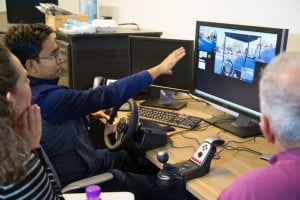
Ford Motors opened a new Research and Innovation Center in Palo Alto in late January that plans to further its partnership with Stanford’s Engineering Department and to accelerate the development of autonomous vehicle technology.
The company chose to heighten its presence in Silicon Valley due to the increasingly computerized nature of vehicles.
“Something like 35 percent of the value of an automobile is now in embedded systems, computer hardware, computer software,” said Ed Krause, Ford’s Global Manager for External Alliances.
Ford also has a long history of working collaboratively with universities across the nation. After partnerships with the Massachusetts Institute of Technology (MIT) in 1998 and with University of Michigan in 2005, Ford approached Stanford with a proposal in 2012. Ford chose Stanford as a partner after doing a fairly thorough assessment.
“Given our activities in the Silicon Valley and the convergence of what’s going on there with what’s going on in the vehicles, we looked in the West Coast area for a university partner,” Krause said. “Proximity is one of the factors, but we chose our lab location after we chose Stanford, not the other way around.”
While Stanford and Ford did not form their strategic alliance until 2012, according to professor of mechanical engineering Chris Gerdes, Stanford has had a long history of cooperation with Ford.
“I believe it was 2005 when we got a grant under the Ford Fund to start building a modular research test bed,” Gerdes said. “That actually grew into the X1 vehicle, which has been the workhorse for many of our projects, including the work between human and machine.”
The Research and Innovation Center will employ 125 researchers, engineers and scientists by the end of 2015. According to Krause, it will operate on an externally-facing, highly collaborative model and work with Gerdes to test the driving limits of automated vehicles.
“Most automated vehicles are very cautious, but Professor Gerdes has done work showing that an automated vehicle on a racetrack can be just about as good as a trained race driver,” Krause said. “Just like racecars help make better passenger cars, the hope is that as we push the envelope with automated driving, we’ll make a better, safer automated vehicle.”
Gerdes’s group focuses on enhancing vehicle safety either by improving the vehicle itself or by improving the skills of the driver. His lab is also instrumental in developing path-planning and prediction algorithms needed to improve autonomous vehicles.
“The idea of path planning is the process of looking at the environment and deciding what route the vehicle should take through that environment,” Gerdes said. “The idea of prediction that we’re interested in with this project is to understand how we might be able to think about things that will occur in the future when we’re making that decision.”
As part of the alliance, Ford provided Gerdes’s lab with a new Ford Fusion autonomous vehicle to test its algorithms.
“A lot of our work has focused on the track of some our student-built test vehicles, so it’ll be wonderful to have a vehicle to use in our research which has much more sensing capability to better perceive the objects in its environment,” Gerdes said.
Krause hopes that the research performed both at Stanford and the Research and Innovation Center will yield improvement in automated driving features – such as automatic cruise control or automatic parallel parking – to ultimately assist in making better drivers. Research will feed directly into the vehicles.
“I think the researchers tend to like that,” Krause said. “They don’t just want to publish a paper and have it be the end of it. They like to see the work implemented, and so do we. Our arrangement with Stanford and our processes are really designed to try to fast-track the work to implementation.”
Contact Alexandra Nguyen-Phuc at nguyenphuc ‘at’ stanford.edu.